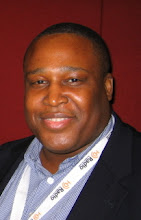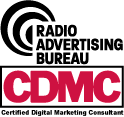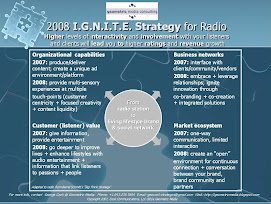If you are a good dj today and you want to break through the clutter to become a great personality tomorrow - and succeed in a digital world - it’s time to UPGRADE. You can no longer afford to think of yourself just a “dj.” YOU ARE A BRAND: a multi-dimensional, multi-sensory, multi-media personality.
Now faced with the challenges of the PPM, shifting media consumption patterns and other issues impacting your ability to capture and hold the attention of time-squeezed (and time-shifting) listeners/users, you must commit to doing whatever you can to develop yourself (with the help of your OM/PD/Consultant) into an IE: “innovative entertainer.” As an innovative entertainer you must think “live” and “on-demand” when creating your content. And you must consider how that content will delivered and exist on-air, online, on the streets and on-device. Everything you do must be creative and compelling because ENGAGEMENT=RATINGS and REVENUE.
If you’re wondering where to begin, just start at the beginning. As with anything, it’s important to get back to basics before you move forward. Make sure you’ve mastered key personality fundamentals to ensure that you are building your brand on a solid foundation for the future. To help, here’s your PERSONALITY PRIMER 101:
1. Credibility is everything…keep it real. The most important quality to cutting through the clutter and succeeding today is to develop a trusting relationship with listeners. They must perceive that you tell the truth, that you tell it like it really is. "Jocking" or announcing is formula. It is being on automatic pilot without any feeling or emotion. Feeling it involves intention and emotion. No feeling, no emotion, no intention equals no communication. Even "coming up next" can either be read or communicated with meaning.2. Finding your voice, your ‘Comic Perspective’… (Outside of current PPM markets) Arbitron is still a game of memory and recall. Breakthrough talents combine credibility with strong characterization, which means expressing yourself with your own vision of the world around you and establishing the essence of your relatability; to people listening who either are like you or your opposite.
Some examples include:- Observational Everyman (normal guy/woman with wacked out people around him/her)
- People pleaser
- Cynic
- Perennially single female
3. The secret to mastering any performance skill is not trying too hard. Trying too hard usually means thinking too much about what you’re doing during performance. The time to think is when you’re planning the show before you go on the air and during songs and commercials. While you’re on the air be alert and completely in the moment. Being a great listener is a major part of being aware and being focused in the present moment.
4. Prep. Prep. Prep. Highly revered basketball coach John Wooden said it best, "Failing to prepare is preparing to fail." Avoid reading or memorizing. Master the material with the goal being spontaneity and sincerity.
5. Pay attention to what’s important. Distractions keep talent from being in the moment and focused on the message, caller or break. Instant Messaging, request lines, sales people, and friends in the studio are just some of the distractions that will keep talent from connecting with listeners.
6. Know the selling priorities. For example with promotions, in a Lil Wayne and T-Pain contest that involved giving away their CD collaboration and a trip to see them perform together live in Miami, the trip is obviously the most enticing part of the giveaway to listeners. The following is a useful guide:
Attention: Think from the listeners perspective and lead with the biggest listener benefit, a headline or hook to get their attention. Using the example above: "Wanna fly to Miami to see Lil Wayne and T-Pain?"
Interest: Make it enticing, alluring to capture their interest…"South Beach, celebrities and the hottest performers in the game today!"
Detail: Use only bottom line, need-to-know information on live sells leaving details to produced promos. "When you hear Lil Wayne and T-Pain back-to-back call to win their new T-Wayne CD and a shot at the Miami Fly Away, we’ll tell you all about in just a few minutes on WGEO-FM.
Action: Urge them to take action…"Listen for Lil Wayne and T-Pain’s new song in the next 20 minutes to win a trip to South Beach...."
7. Sell the call letters/station name with pride and enthusiasm and say them a lot. Say the station calls/name often as you can work it in to conversation and to make it stand out. Look for new and different ways to highlight the station/name. It’s been proven in Arbitron over and over that the stations with the most name mentions tend to have higher recall and therefore cume. (This will change when your market is measured by PPM...right now---you're still in a diary-recall world!)
8. Focus on getting more TSL. The best talent are focused on ONE mission -- stretching TSL. Talent can press the flesh to build cume, but on air there is really only one thing they can do to increase ratings: convince that moment’s audience to keep listening or tune in again another time. Lead with something great that will get listener’s attention and keep them listening, or tease upcoming content to generate another listening occasion.
9. Talking in music sweeps: make a song-to-song segue by hitting the second song at full volume, let it establish for approximately one second, and then talk over the song intro. The exception to this guideline would be with cold/no intro songs, and then it is acceptable to talk on the back fade of the song quickly. Avoid ‘bridging two songs’, where the jock starts talking on the fade of one song and then starts the second song under the rap. Forward momentum and energy is increased when you hit the next song and deliver your quick message. Note: It is important to totally respect the music in some formats where its policy not to talk over the music at all. If there is any talk in music sweeps it’s done between songs.
10. Avoid letting songs fade too long. Take the song out at the point that the song starts to fade, in other words, before there is any noticeable fade on the air. Hit the next song at slightly higher volume and pull the previous song volume down. Of course you don’t want to cut the song in the middle of a word, which would make it obvious to listeners, but you can exit on the end of a refrain or phrase while the song is still hot.
11. Avoid talking over any vocals on song intros. It sounds fine to talk between any vocal intros, as long as it’s not vocal-over-vocal. And remember the cardinal rule of good delivery: just because it’s a 60 second ramp, doesn’t mean you HAVE to chat it up for 60 seconds.
12. Focus on one main thought/theme per talk break. By doing this you increase the chance of your message or content being remembered by listeners. The typical listener is listening with something less than 20% of their consciousness. To have a chance at delivering a message that gets through, it needs to be focused on one important thing they care about. Multiple thought breaks and laundry lists of upcoming content obscure the important message and detract from memorability.
13. Pot up low level intros all the way to full volume so there is no drop on the air. Keeping the audio levels consistent is good for TSL. Constantly changing audio levels is annoying and a cause of tune-out.
14. The voice-to-music ratio when talking over song intros should be similar to that of a lead singer’s voice in a song. Listeners will ideally hear the voice being slightly dominant over the music, yet both clearly audible -- you don’t want to be buried by the music nor have the voice to be so dominant that it obscures the music. The exact right place to be in the music and your distance from the microphone are two variables to play with. Listen to tapes of your show with different settings and see how it sounds without headphones on. Headphones can make things sound very different from car speakers in rush hour.
15. Make music beds repetitive and consistent without a lot of distracting musical changes. Avoid horns and vocals. The main purpose of using beds is to lift the energy level of conversations and fill in dead spaces. Listeners shouldn’t notice beds unless they’re used for staging to get listeners’ attention.
16. Be quick- but don’t hurry. There’s a difference between being efficient and succinct and rushing through conversations. If you hurry, you’re more likely to make mistakes, but if you’re not quick, you won’t get things done and you will bore your listener. The bottom line is to be a good self-editor. This is particularly important for set ups. The set up to any bit, interview, feature, etc. is critical to its success.
17. Set Ups: Clearly and enthusiastically set up a feature, bit or conversation to get listeners’ attention and pique their interest. Listeners make a mental decision on whether to listen to something after the first sentence of introduction.
18. Exits: Don’t miss the exit on the freeway -- remember to get out at an impact point. Develop a sense for when to end a conversation, bit, etc. Leave the listeners on a high note with something strong and memorable.
19. Branding. Get ownership of your content by attaching the station and/or show name to all features. Creative and entertaining produced intros and outros help you brand content.
20. Teasing. Teasing upcoming content is the absolute best way to fuel TSL. This also adds to people feeling like they’re going to miss something if they don’t listen every day or listen longer. TV entertainment shows and newscasts have made an absolute science out of enticing billboarding and teasing to create momentum and build longer viewing. They devote 25% of content time to previewing! Talent who ‘get’ the art of teasing will consistently outperform talent who don’t.
(Special thanks to morning show consultant Randy Lane)








 So all of this begs the question: What is your podcasting plan?
So all of this begs the question: What is your podcasting plan? 


